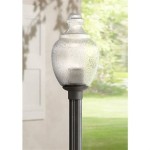Motion Sensor For Outdoor Light
Motion sensors are an increasingly popular addition to outdoor lighting systems, offering a range of benefits for both homeowners and businesses. These devices utilize passive infrared (PIR) technology to detect movement in a designated area, automatically activating lights when needed. By responding to motion, motion sensors help to conserve energy, improve security, and enhance convenience. This article will delve into the workings of motion sensors, explore their key advantages, and provide guidance on choosing the right sensor for your outdoor lighting needs.
How Motion Sensors Work
Motion sensors operate by detecting changes in infrared radiation emitted by objects within their field of view. PIR sensors consist of a lens that focuses infrared radiation onto a pyroelectric sensor. This sensor is sensitive to changes in temperature, and when it detects a sudden increase in infrared radiation, it triggers the activation of the connected lights. The sensitivity and detection range of a motion sensor can vary depending on factors such as the type of sensor, its placement, and environmental conditions.
The activation time of a motion sensor can also be adjusted. This setting determines how long the lights will remain on after detecting movement. Some sensors also offer adjustable delay settings, allowing users to fine-tune the duration of light activation based on their specific requirements.
Benefits of Using Motion Sensors For Outdoor Lighting
Motion sensors provide several advantages for outdoor lighting applications, making them a worthwhile investment for homeowners and businesses alike.
Energy Savings
One of the most significant benefits of motion sensors is their ability to conserve energy. By activating lights only when needed, motion sensors prevent unnecessary energy consumption. This is particularly beneficial for outdoor lighting, which often remains on for prolonged periods, particularly in areas with high levels of foot traffic or security concerns. By utilizing motion sensors, homeowners and businesses can reduce their electricity bills and minimize their carbon footprint.
Enhanced Security
Motion sensors can significantly enhance security by deterring potential intruders. The sudden activation of bright lights when movement is detected often acts as a deterrent, alerting potential intruders to the presence of security measures. Motion sensors can also be integrated with other security systems, such as alarms and cameras, providing an added layer of protection.
Convenience and Comfort
Motion sensors provide convenience and comfort by automating the lighting process. With motion sensors in place, homeowners and visitors no longer need to manually switch lights on and off. This is particularly helpful in areas like driveways, walkways, and patios, where lighting is often required for short periods. Motion sensors eliminate the need for fumbling for light switches in the dark, enhancing safety and convenience.
Choosing the Right Motion Sensor
When selecting a motion sensor for outdoor lighting, several factors should be considered to ensure optimal performance and suitability for the specific application.
Coverage Area
The coverage area of a motion sensor is critical to ensure that it effectively detects movement in the desired area. Consider the size of the space to be illuminated and the desired range of detection. Motion sensors are available in various coverage areas, ranging from narrow beams to wide-angle coverage.
Sensitivity
The sensitivity of a motion sensor determines how readily it detects movement. Higher sensitivity levels can trigger activation with smaller movements, while lower sensitivity levels require more substantial movement to trigger the lights. The ideal sensitivity level will depend on the specific requirements of the application.
Installation
The installation process for motion sensors can vary depending on the type of sensor and the existing lighting system. Some sensors are designed for easy DIY installation, while others may require professional assistance. It is essential to consider the ease of installation and the availability of necessary tools and expertise.
Conclusion
Motion sensors for outdoor lighting offer a compelling solution for homeowners and businesses seeking to enhance security, conserve energy, and improve convenience. By understanding how these devices work, their key benefits, and the factors to consider when selecting a sensor, individuals can make informed decisions that meet their specific needs and expectations.

Auraglow Pir Motion Sensor Up Down Outdoor Wall Security Light Warminster Stainless Steel Led Lighting

Best Outdoor Motion Sensor Lights 2024 Security

Lepro 20w Security Lights Outdoor Motion Sensor 1700 Lumen Pir Light Ip65 Waterproof Flood

Philips Hue Outdoor Motion Sensor Review Macrumors

Motion Sensor And Dusk To Dawn Decorative Outdoor Lighting Deep Discount

Sambesi Pir Sensor Outdoor Wall Light

Up And Down Pir Motion Sensor Wall Light For Outdoor Use

Best Motion Detector Lights Of 2024 Safewise

John Timberland Deaver 15 1 4 Broe Motion Sensor Outdoor Wall Light 33h55 Lamps Plus

Auraglow Black Arch Integrated Led Motion Sensor Pir Outdoor Wall Light Adobe Lighting
Related Posts







